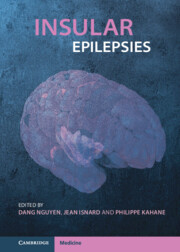Book contents
- Insular Epilepsies
- Insular Epilepsies
- Copyright page
- Contents
- Contributors
- Foreword
- Chapter 1 A Brief History of Insular Cortex Epilepsy
- Section 1 The Human Insula from an Epileptological Standpoint
- Section 2 The Spectrum of Epilepsies Involving the Insula
- Section 3 Noninvasive Investigation of Insular Epilepsy
- Chapter 13 Noninvasive Electrophysiological Investigations in Insular Epilepsy
- Chapter 14 Structural Imaging of Insular Epilepsy
- Chapter 15 PET and SPECT in Insular Epilepsy
- Chapter 16 Neuropsychology of Insular Epilepsy
- Section 4 Invasive Investigation of Insular Epilepsy
- Section 5 Surgical Management of Insular Epilepsy
- Index
- References
Chapter 14 - Structural Imaging of Insular Epilepsy
from Section 3 - Noninvasive Investigation of Insular Epilepsy
Published online by Cambridge University Press: 09 June 2022
- Insular Epilepsies
- Insular Epilepsies
- Copyright page
- Contents
- Contributors
- Foreword
- Chapter 1 A Brief History of Insular Cortex Epilepsy
- Section 1 The Human Insula from an Epileptological Standpoint
- Section 2 The Spectrum of Epilepsies Involving the Insula
- Section 3 Noninvasive Investigation of Insular Epilepsy
- Chapter 13 Noninvasive Electrophysiological Investigations in Insular Epilepsy
- Chapter 14 Structural Imaging of Insular Epilepsy
- Chapter 15 PET and SPECT in Insular Epilepsy
- Chapter 16 Neuropsychology of Insular Epilepsy
- Section 4 Invasive Investigation of Insular Epilepsy
- Section 5 Surgical Management of Insular Epilepsy
- Index
- References
Summary
Structural brain MRI is an indispensable tool in the diagnosis and management of patients with insular epilepsy. Similar to the pathology of other focal epilepsies MRI lesions span from the obvious to the occult cortical malformations, along with vascular malformations, neoplasms, encephaloclastic lesions (e.g., after stroke or trauma), and less frequent etiologies including Rasmussen encephalitis. The incidence of MRI-negative focal epilepsy arising from the insula is unknown. Appropriate epilepsy MRI protocol is a necessary, but not sufficient requirement for the structural exploration of the insula. Interpretation of the study strongly depends on the reader’s expertise in imaging of epilepsy. Advances in image processing and multimodality imaging have increased the diagnostic yield of MRI studies in nonlesional insular epilepsies and in particular in patients with occult focal cortical dysplasia, including bottom of the sulcus dysplasia. The utility of emerging approaches, such as 7-Tesla and quantitative MRI studies, in the evaluation of insular epilepsies is now being explored. Finally, the importance of re-interpreting each visually identifiable MRI lesion or postprocessing MRI finding in the context of the individual clinical presentation cannot be overemphasized.
- Type
- Chapter
- Information
- Insular Epilepsies , pp. 163 - 178Publisher: Cambridge University PressPrint publication year: 2022
References
- 1
- Cited by



